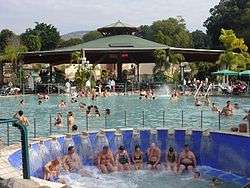Hamat Gader



Hamat Gader (Hebrew: חַמַּת גָּדֵר; Aramaic: חמתא דגדר, Hammata Degader; Ancient Greek: Ἑμμαθά, Emmatha or ῎Αμαθα, Amatha;[1] Arabic: الحمة السورية El-Hamma El-Souriya, meaning "The Syrian Hamma") is a hot springs site in the Yarmouk River valley, used since the Classical antiquity. It is located in an area under Israeli control, in what was a demilitarized zone between Israel and Syria from 1949 to 1967.[2] The site is next to the Jordanian border, and about 10 kilometres (6.2 mi) from the tripoint of Israel, Jordan and Syria. It is set on several mineral springs with temperatures up to 50 °C.
Etymology
The ancient Hebrew name means hot springs of (the ancient city of) Gadara. The latter is above the springs, in modern Umm Qais. The Arabic name El-Hamma preserves this, and the name of the mound located near the site, Tel Bani, is a corruption of the Latin word meaning "baths".
History
Hamat Gader was already a widely known health and recreation site in Roman times.[3] It is mentioned in Strabo,[4] Origen[5] and Eunapius,[6] as well as the Rabbinic literature of the first centuries AD.
Construction of the bath complex began in the 2nd century by the 10th Roman Legion, which was garrisoned in the city of Gadara. Two distinct construction periods are evident at the site: The Roman-Byzantine Period, during which most of the bath complex was built, and the Muslim period, during which major changes were made to the existing structures.[7]
The site includes a Roman theatre, which was built in the 3rd century CE and contained 2,000 seats. A large synagogue was built in the 5th century CE.[8]
Some of the buildings were damaged by an earthquake and restored in 633 by the Umayyad caliph who ruled from Damascus. A century later the 749 Galilee earthquake hit. Eventually, in the 9th century, the baths were abandoned and a thick layer of silt covered the ruins.
Modern history
Before 1949, the Palestinian Arab village Al-Hamma was located at this site. At the time of the 1931 census, it had 46 occupied houses and a population of 170 Muslims, 1 Jew and 1 Christian.[9]
The border between the Mandatory Palestine and the French Mandate for Syria and the Lebanon was drawn in 1923, and Al-Hamma was included in Palestine.[10]
After the 1948 Arab–Israeli War, according to the armistice agreements of 1949 Between Israel and Syria, it was determined that the area would be included in the demilitarized zone (DMZ) between Israel and Syria. The villagers and their property were formally protected by Article V of the Israeli-Syrian agreement of 20 July that year.[11][12] However, Israel thought the Arab villagers could pose a security threat, and Israeli settlers and settlement agencies coveted the land. Israel therefore wanted the Palestinian inhabitants, a total of 2,200 people, moved to Syria.[11]
On April 4, 1951, a force of Israeli soldiers and Border Police set out for Hamat Gader in order to assert Israeli sovereignty over the site. Since Israel was not allowed to have soldiers in the DMZ, members of the patrol were disguised as policemen.[13] Syrian soldiers guarding the entrance to Hamat Gader ordered them to turn back immediately, but the Israeli force refused. Once the Israeli force had passed, the Syrians opened fire. Of the 22 soldiers and policemen in the force, seven were killed, three were wounded and one was taken prisoner. The skirmish became known as the Al-Hamma Incident.
Israeli control over Hamat Gader was secured during the Six-Day War in 1967, when the Israeli army occupied the surrounding Golan Heights, allowing free access to Hamat Gader for Israelis. Since then, it has been under Israeli control and has been developed as a tourist attraction, health resort and an alligator and exotic bird reserve. The health resort opened in 1977.[14]
Today, Hamat Gader also includes a crocodilian farm with crocodiles, alligators and even caimans and gavials. It has about 200 crocodilians and it is the largest crocodile farm in the Middle East.
Hot springs
Hamat Gader is Israel's largest and oldest spa complex. The crocodile farm complex includes thermal baths. The water contains sulfur at a concentration of 4.7%, which may have a therapeutic effect on skin diseases, asthma, rheumatism and wrist pain, as well as renew skin cells.
References
- ↑ Brown, J., E. Meyers, R. Talbert, T. Elliott, S. Gillies. "Places: 678131 (Emmatha)". Pleiades. Retrieved August 8, 2014.
- ↑ Israel to build dam on disputed land claimed by Syria New York Times, 26 August 1997
- ↑ Hirschfeld, Yizhar (1987). "The History and Town-Plan of Ancient Ḥammat Gādẹ̄r". Zeitschrift des Deutschen Palästina-Vereins. 103: 101–116. JSTOR 27931308.
- ↑ Geog. XVI, 45.
- ↑ Commentary on St. John, VI, 41, 210
- ↑ Vit. Soph. 368-370. Ma'oz, Zvi Uri (1997). "HAMMATH-GADER". The Oxford Encyclopedia of Archaeology in the Near East. p. 468. ISBN 0195112156.
- ↑ Hamat Gader Information Site
- ↑ Eleazar Sukenik, "The ancient synagogue at Hamat Gader" (in Qobes, Jewish Palestine Exploration Society, 1934), pp. 41-61
- ↑ E. Mills, ed. (1932). Census of Palestine 1931. Population of Villages, Towns and Administrative Areas. Jerusalem: Government of Palestine. p. 82.
- ↑ "The Line of June 4, 1967", Frederic C. Hof, Jewish Virtual Library
- 1 2 Morris, Benny (2004). The Birth of the Palestinian Refugee Problem Revisited. Cambridge University Press. p. 513. ISBN 978-0-521-00967-6.
- ↑ UN Doc S/1353 Syria Israel Armistice Agreement of 20 July 1949
- ↑ Morris, 1993, p.363, citing Shalev: Shituf-Peula, 168-73
- ↑ Hamat Gader in the 20th Century
External links
- Hamat Gader Information (Hebrew)
- Hamat Gader at the Israeli Ministry of Foreign Affairs site.
- Hamat Gader Hot Springs
Coordinates: 32°41′2.51″N 35°39′55.43″E / 32.6840306°N 35.6653972°E